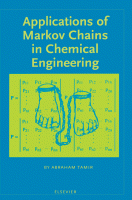Browse content
Table of contents
Actions for selected chapters
- Full text access
- Book chapterAbstract only
Chapter 0 - Biblical origins and artistic demonstrations of Markov chains a humorous introduction
Pages 1-5 - Book chapterAbstract only
Chapter 1 - Why write this book?
Pages 6-10 - Book chapterAbstract only
Chapter 2 - Fundamentals of Markov chains
Pages 11-185 - Book chapterAbstract only
Chapter 3 - Application of Markov chains in chemical reactions
Pages 186-333 - Book chapterAbstract only
Chapter 4 - Application of Markov chains in chemical reactors
Pages 334-497 - Book chapterAbstract only
Chapter 5 - Applications of Markov chains in chemical processes
Pages 498-589 - Book chapterNo access
Nomenclature
Pages 590-598 - Book chapterNo access
References
Pages 599-604
About the book
Description
Markov chains make it possible to predict the future state of a system from its present state ignoring its past history. Surprisingly, despite the widespread use of Markov chains in many areas of science and technology, their applications in chemical engineering have been relatively meager. A possible reason for this phenomenon might be that books containing material on this subject have been written in such a way that the simplicity of Markov chains has been shadowed by the tedious mathematical derivations. Thus, the major objective of writing this book has been to try to change this situation.
There are many advantages, detailed in Chapter 1, of using the discrete Markov-chain model in chemical engineering. Probably, the most important advantage is that physical models can be presented in a unified description via state vector and a one-step transition probability matrix. Consequently, a process is demonstrated solely by the probability of a system to occupy or not occupy a state.
The book has been written in an easy and understandable form, where complex mathematical derivations are abandoned. The fundamentals of Markov chains are presented in Chapter 2 with examples from the bible, art and real life problems. An extremely wide collection is given of examples viz., reactions, reactors, reactions and reactors as well as combined processes, including their solution and a graphical presentation of it, all of which demonstrates the usefulness of applying Markov chains in chemical engineering.
Markov chains make it possible to predict the future state of a system from its present state ignoring its past history. Surprisingly, despite the widespread use of Markov chains in many areas of science and technology, their applications in chemical engineering have been relatively meager. A possible reason for this phenomenon might be that books containing material on this subject have been written in such a way that the simplicity of Markov chains has been shadowed by the tedious mathematical derivations. Thus, the major objective of writing this book has been to try to change this situation.
There are many advantages, detailed in Chapter 1, of using the discrete Markov-chain model in chemical engineering. Probably, the most important advantage is that physical models can be presented in a unified description via state vector and a one-step transition probability matrix. Consequently, a process is demonstrated solely by the probability of a system to occupy or not occupy a state.
The book has been written in an easy and understandable form, where complex mathematical derivations are abandoned. The fundamentals of Markov chains are presented in Chapter 2 with examples from the bible, art and real life problems. An extremely wide collection is given of examples viz., reactions, reactors, reactions and reactors as well as combined processes, including their solution and a graphical presentation of it, all of which demonstrates the usefulness of applying Markov chains in chemical engineering.
Details
ISBN
978-0-444-82356-4
Language
English
Published
1998
Copyright
Copyright © 1998 Elsevier B.V. All rights reserved
Imprint
Elsevier Science
